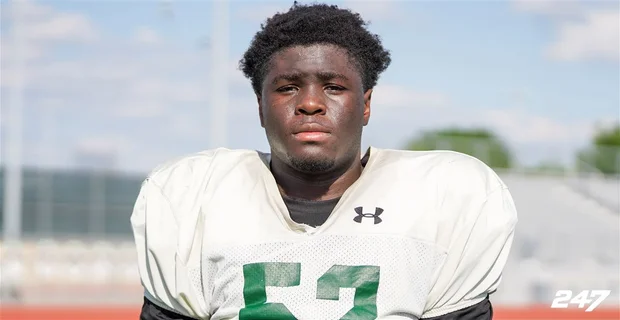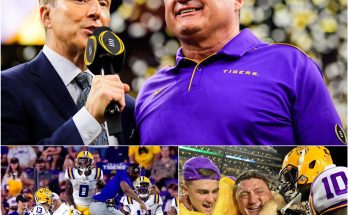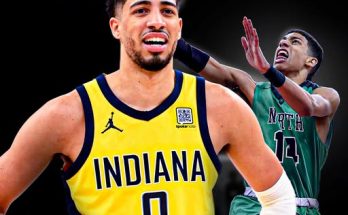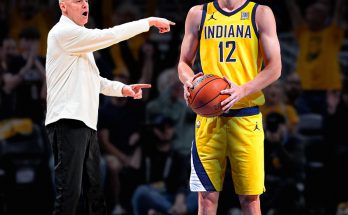Kentucky has landed a major recruiting win by flipping four-star wide receiver Denairius Gray from Auburn.
The University of Kentucky has pulled off a major recruiting coup, flipping four-star wide receiver Denairius Gray from Auburn and adding a dynamic offensive weapon to its future roster. Gray’s commitment marks a significant shift in momentum for the Wildcats, who continue to make inroads in the fiercely competitive Southeastern Conference recruiting landscape. The 6-foot-1, 180-pound wideout had been committed to Auburn since March, but Kentucky’s persistent pursuit, vision for offensive growth, and the relationships built by the coaching staff ultimately changed the tide.
Denairius Gray, out of Manchester High School in Georgia, is regarded as one of the top playmakers in the Southeast. Known for his elite speed, route-running ability, and versatility on the field, Gray had garnered offers from a slew of top programs including Georgia, Florida State, Tennessee, and Miami. His initial commitment to Auburn was viewed as a major win for the Tigers, who have been working to bolster their offensive skill positions under their current coaching regime. However, as the recruiting cycle progressed, Kentucky remained aggressive, maintaining constant communication with Gray and continuing to show unwavering interest in his development and long-term fit within their offensive scheme.
For Kentucky, this flip is about more than just adding talent; it represents a statement of intent. The Wildcats are working to elevate their offensive production and stretch the field vertically, and Gray fits that blueprint perfectly. His game-breaking speed and natural instincts after the catch make him a serious threat to opposing defenses. At the high school level, he has torched secondaries with his ability to create separation and turn short gains into explosive plays. His senior year statistics reflected that impact, recording over 1,000 receiving yards and double-digit touchdowns, numbers that made him a standout in Georgia’s competitive high school football scene.
What makes this flip particularly significant is the broader context within which it occurred. Auburn, a program with a rich football tradition and a passionate fan base, had appeared to solidify Gray’s commitment early in the year. The Tigers had made him a priority, selling him on the opportunity to be an immediate contributor in their offense. But Kentucky’s coaching staff, led by head coach Mark Stoops and offensive coordinator Bush Hamdan, never let up. They emphasized Gray’s role in their evolving offensive identity, one that is becoming more pass-oriented and dynamic.
The Wildcats have been steadily building a reputation as a program that not only competes in the SEC but also develops NFL-ready talent. The recent success of players like Wan’Dale Robinson and the offensive strides made in recent years have helped change the narrative around Kentucky football. Recruits now see Lexington not just as a place to play in the toughest conference in the country, but as a destination where they can shine and prepare for the next level. That changing perception played a pivotal role in Gray’s decision to reconsider his initial pledge to Auburn.
Recruiting in the SEC has always been intense, with programs vying for a limited pool of elite talent. Flipping a player of Gray’s caliber is not an everyday occurrence, especially from a direct conference rival. It underscores the level of effort Kentucky’s staff is putting into evaluations, relationship-building, and persistence. Gray has spoken highly of Kentucky’s staff in interviews, noting their consistency and the genuine nature of their pitch. For a young athlete weighing life-changing decisions, that trust can be the difference between staying committed and making a switch.
The addition of Gray gives Kentucky a significant boost to its 2025 recruiting class, which is beginning to take shape as one of the strongest of the Stoops era. With Gray now in the fold, the Wildcats not only add a player who can stretch the field and contribute immediately, but they also send a strong message to other recruits and programs around the SEC: Kentucky is here to compete at the highest level. Momentum is critical in recruiting, and this win over Auburn could spark a chain reaction that benefits the Wildcats throughout the rest of the cycle.
From a strategic standpoint, Gray’s skill set opens up a world of possibilities for Kentucky’s offense. He’s capable of lining up outside, in the slot, or even coming out of the backfield on designed plays. His footwork, agility, and ability to adjust to the ball mid-route make him a matchup nightmare. Defenses will have to account for his presence on every play, which in turn should help open things up for other offensive weapons on the roster. If Kentucky continues to stack talent like this, their offensive identity could shift in a way that makes them not only competitive but dangerous in a conference known for elite defensive play.
This recruitment also highlights the increasing importance of player relationships, vision, and communication in the NIL era. While name, image, and likeness opportunities are a factor for many top recruits, Gray’s decision appeared to hinge more on fit, development, and trust. Kentucky’s staff demonstrated that they had a plan for him and communicated it clearly throughout the process. They made him feel like a priority, not just another name on the board. That human element, which often gets overlooked in discussions about recruiting rankings and highlight reels, proved to be the key.
Gray’s high school coach has praised him not just for his athletic ability, but for his work ethic and leadership qualities. He’s known for his dedication to film study, willingness to stay late after practice, and hunger to improve his game. Those traits will serve him well at the collegiate level, particularly in a competitive SEC environment where attention to detail and resilience are necessary for success. Kentucky is getting more than just an explosive receiver; they’re getting a young man who is committed to his craft and ready to compete.
The commitment also serves as validation for Kentucky’s efforts in expanding its recruiting footprint. While they’ve traditionally drawn heavily from in-state talent and nearby regions, pulling a highly sought-after player from Georgia—one of the richest football states in the country—is no small feat. It signals that Kentucky is becoming a more national brand in recruiting circles, able to compete with the likes of Auburn, Georgia, and others for premier prospects in the South.
Looking ahead, Gray’s presence in the class should help attract additional talent. Recruits often pay attention to who else is joining a class, and when a dynamic player like Gray chooses a program, it can start a domino effect. Skill position players want to play alongside other explosive athletes, and quarterbacks in particular take notice of elite receivers who can make their jobs easier. Kentucky’s ability to recruit top-level quarterbacks and offensive linemen could now be enhanced with Gray as a centerpiece of their future offense.
In the broader scheme of college football, this flip underscores how fluid recruiting has become. Commitments, while important, are no longer ironclad. Coaching staffs have to stay engaged, creative, and diligent throughout the entire process. Kentucky demonstrated that it can play the long game, remain strategic, and ultimately succeed even when facing uphill battles against established powerhouses. That kind of persistence is exactly what allows programs to evolve from mid-tier contenders to legitimate threats in their conference.
For Auburn, the loss of Gray stings. He was a player they had targeted early and worked hard to secure. While they will undoubtedly pivot and continue their efforts to land other top-tier prospects, losing a player of Gray’s caliber—especially to a conference rival—is a tough pill to swallow. It also puts added pressure on Auburn’s staff to reinforce their own recruiting base and avoid further decommitments as the cycle progresses.
For Gray, this decision sets the stage for a promising collegiate career in Lexington. He’ll arrive with high expectations and a fan base eager to see what he can do on the field. But all signs point to a player who embraces pressure and thrives in competitive environments. Kentucky’s investment in him is as much about the future as it is about the present. With continued development and the right opportunities, Denairius Gray has the potential to become one of the most electrifying wide receivers in the SEC.
The recruiting battle for Denairius Gray may be over, but the ripple effects of his flip from Auburn to Kentucky will be felt well beyond this summer. It’s a reminder that in college football, recruiting is the lifeblood of success, and securing game-changing players like Gray is how programs rise. For Kentucky, this is more than a win—it’s a sign of what’s possible when vision, persistence, and belief in a player align at the right moment.



